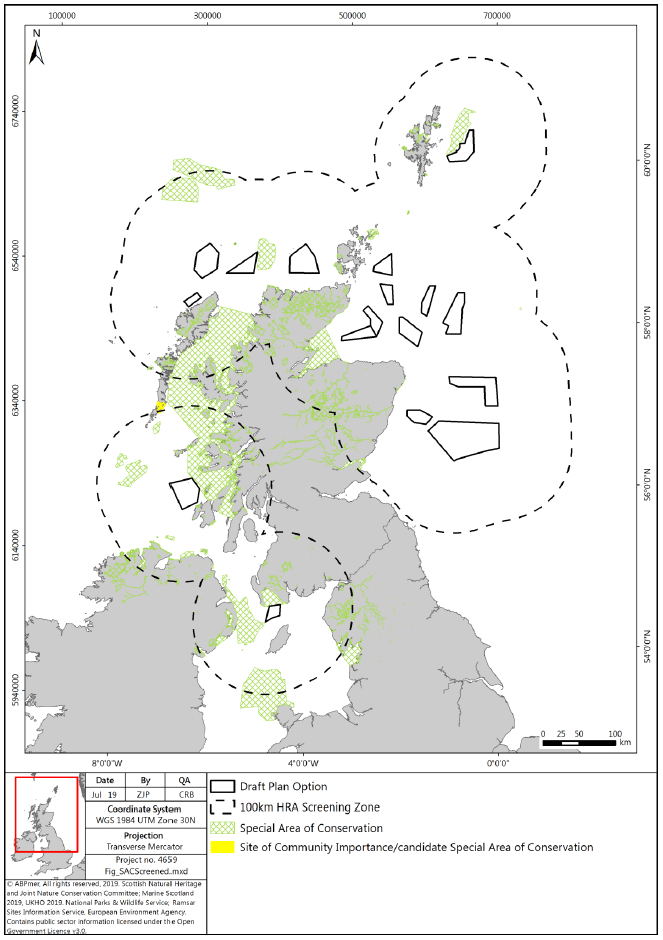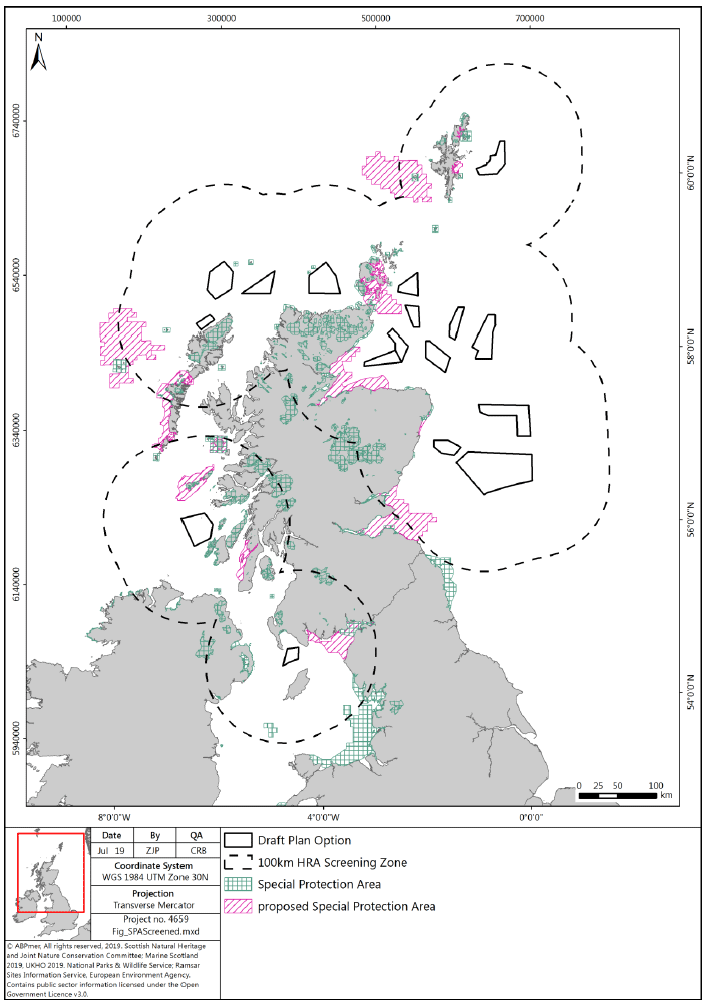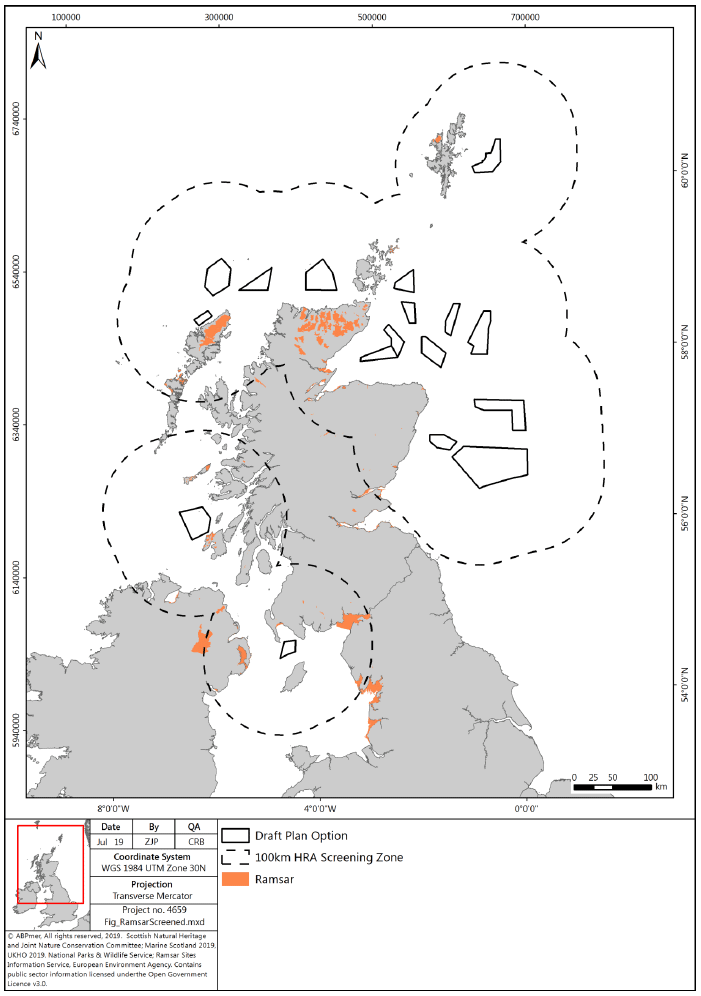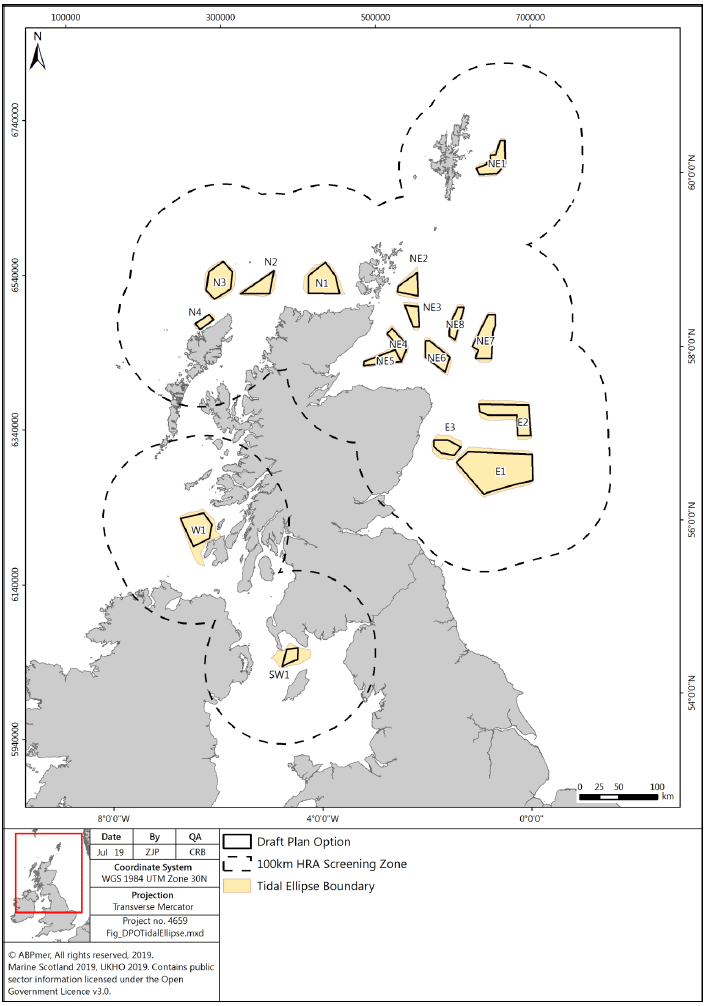Offshore wind energy - draft sectoral marine plan: habitat regulations appraisal
The habitats regulations appraisal is completed in accordance with the Habitats Regulations that implement the EC Habitats and Birds Directives in UK waters and has been completed for the sectoral marine plan for offshore wind.
2 Screening/Scoping (Stage 5)
2.1 Introduction and Scope
2.1.1 The screening or ‘scoping’ stages of the plan-level HRA process involve a secondary sifting process whereby the list of European/Ramsar sites and features which was identified during the pre-screening are reviewed to identify those sites for which there is the potential for a LSE (or where the likelihood of a LSE cannot be excluded) from the plan. These sites and features are then taken forward in the assessment stage. At the same time those sites and features for which there is no LSE or relevant impact pathway from the plan can be ‘screened out’ and do not need to be considered further within the assessment.
2.1.2 Proposed methods for making this Stage 5 LSE screening judgement were set out within the Phase 1 Pre-screening report and then updated, following consultation and agreement with the PSG, in the Phase 2 methods review report (see Appendices A and B respectively). These methods were informed by initial literature reviews and by the advice received from stakeholders, and screening principles applied, during previous plan-level HRAs. Based on these methods and advice from the PSG, this section of the report sets out the final list of ‘screened in’ sites that have been taken forward into the assessment.
2.1.3 The DPOs had not been agreed at the time of writing the Phase 1 and 2 reports. Hence, a precautionary ‘pre-screening buffer zone’ was adopted in these stages which encompassed the EEZ around Scotland plus a 100 km buffer south of the Scottish border (see Figure 5 of Appendix A). These resulted in a large number of European/Ramsar sites (652) being encompassed by the extensive geographical area covered by the ‘pre-screening buffer zone’.
2.1.4 It was recognised in the pre-screening report (Appendix A) that a more detailed consideration of LSE on European/Ramsar sites and interest features would be carried out in the following screening stage (Stage 5). To provide a fully auditable trail through the HRA process, the original pre-screening list of European/Ramsar sites is provided (Table A3, Appendix A); however, appreciating that many of these sites are beyond the 100 km buffer, a rationalised list of sites was established as the ‘initial screening list’ (Table C1, Appendix C). This initial list encompassed all sites within 100 km of the DPOs as its starting point. It is to this screening list (Table C1, Appendix C) that all updates were made throughout the screening process.
2.1.5 During the pre-screening phase, consideration was given to bat interest features. However, as no bat interest features were within the extensive pre-screening buffer zone, these were not considered further within the HRA (see Appendix A).
2.1.6 In making judgement about the potential for a LSE on designated sites and features, interlinked factors were considered such as the impacts arising from DPO areas, the distance from the sites to features as well as current scientific understanding (and gaps in that understanding) about the ecology, behavioural characteristics and ‘sensitivities’ of the interest features.
2.1.7 It was also necessary at screening (and throughout the HRA process) for a precautionary approach to be adopted and to ensure that no relevant sites or features were excluded. Full consideration was given to the definitions and interpretations of the LSE judgement. Under the Habitats Regulations, LSE is defined as a more than ‘de minimis’ change. In other words, a plan would not be considered to have a LSE on a European/Ramsar site if “any potential effects are trivial, or ‘de minimis’ or so restricted or remote from the site that they would not undermine the conservation objectives for the site in combination”[17].
2.1.8 Several initial steps to the screening were carried out before a further review of each of the key interest feature groups (i.e. coastal, intertidal and subtidal habitats and associated species; bird species; marine mammal species; migratory fish and freshwater pearl mussel; otter) was done. These steps, as outlined below, were captured in the screening table (see Table C1).
2.1.9 Since finalising the Phase 1 and Phase 2 reports, the DPOs have now been agreed. Subsequently, as an initial step to the screening, a 100 km buffer zone was applied to all the DPOs. A 100 km screening boundary has been applied for previous plan-level HRAs and is used because it defines a quantifiable and objective area that is likely to encompass many of the mobile species interest features (fish, seabirds and mammals) within European/Ramsar sites which could be indirectly affected by the Draft Plan. However, it has not been used to limit further review of more distant locations or to presume that all relevant features within this area for which impact pathway exists are necessarily affected. In particular, it is recognised that impacts (especially to migratory bird species) may extend to sites beyond this 100 km boundary and this aspect has been considered within the review of the key interest feature groups that encompass mobile features that range beyond 100 km i.e. birds, marine mammals and migratory fish (Sections 2.3, 2.4 and 2.5).
2.1.10 During Stage 4 of the HRA process, SNH advised that Category D sites and features which are a ‘non-significant presence’ and of ‘little conservation value’ do not need to be considered within the HRA process (see Appendix B). Sites and features identified as Category D have therefore been removed during the initial screening. This included removal of habitats with a ‘non-significant presence’ and species identified as a ‘non-significant population’ from several SACs.
2.1.11 To ensure the most up-to-date information was used, the latest version of the JNCC Natura features database (17th September 2018) was downloaded and the data interrogated for the screening process. Similarly, all GIS shapefiles of the European/Ramsar sites were obtained from the most recent updates available on the JNCC website and NPWS website (as at 19/07/19).
2.1.12 Terrestrial/freshwater habitats and associated species interest features for which there will be no LSE on the basis that there is definitely no impact pathway (i.e. no potential physical or ecological connectivity with any marine activities resulting from the Plan) have been removed during initial screening[18]. Details of this step are provided in Appendix A.
2.1.13 These steps are presented in the updated screening table (Table C1) and Figure 3 to Figure 5 which show all European/Ramsar sites that were screened in following these initial screening steps. A further review of each of the key interest feature groups was then carried out as detailed within Section 4 of the pre-screening report (Appendix A). A set of individual screening schedules were then prepared for each of the DPOs (Appendix D, D1-D17) along with maps showing those sites screened in (Appendix E, Figures E1 to E17).
2.1.14 Other sites outside the 100 km buffer have also been screened in for foraging bird interest feature species, marine mammals and migratory fish. These are reviewed in Sections 2.3 to 2.5. Appendix F presents screening maps of European/Ramsar sites supporting features occurring outside of 100 km buffer.
2.1.15 To underpin the screening steps, reviews of the baseline conditions for birds, mammals and fish were carried out (Appendices G, H and I).
2.1.16 The screening methods recognised the need to consider the likely cable alignments and landfall positions in order to help define areas of potential effects especially within the coastal zone (Section 4 of Appendix A). While the DPOs define the areas for potential wind energy generation, at this time there remains a high level of uncertainty concerning the possible location and number of power export cables associated with potential developments. Therefore, the possibility of the remaining sites and their relevant interest features being directly or indirectly affected cannot be excluded. Consequently, all European/Ramsar sites that occurred within 100 km buffer of the DPOs remained screened into the HRA. The exception to this is where marine sites were located well seaward of any DPO and therefore definitively beyond any potential cable alignment activity associated with the Plan.
2.1.17 The following sections present an outline of the screening process and the summary findings for each marine interest feature group. In each case the methods are not repeated in detail but the relevant section of the pre-screening report (Appendix A) which describes these methods is referenced.
2.2 Habitats and Associated Species
2.2.1 The methods for screening habitats and their associated species were set out in Section 4.3 of the pre-screening report (see Appendix A). Summary details about how these methods were applied and the results of their application are set out below.
2.2.2 From the pre-screening, all relevant SACs/SCIs and Ramsar sites that were within the pre-screening buffer zone (see Section 2.1.3) were included. Following agreement of the DPOs, this list was rationalised in the initial screening by first adopting a 100 km buffer zone around each of the DPOs and then removing all Category D sites and features.
2.2.3 Terrestrial/freshwater habitats, along with their associated species, that would not be affected by the Draft Plan were also screened out. Further consideration of the screening process for freshwater pearl mussels outside the 100 km buffer is provided in Section 2.5.
2.2.4 All the European/Ramsar sites and features that are screened in according to the initial steps are presented in the updated screening table (Table C1, Appendix C) and are shown in Figure 3 to Figure 5. A separate map of sites has not been prepared which specifically identifies those sites for which habitats are a qualifying interest feature. This is because it is expected that the habitats within all the sites will be important for supporting relevant interest features (e.g. as foraging grounds for feeding birds species) irrespective of whether they are qualifying features in their own right.
2.2.5 While the DPOs are known, there are no definitive locations for the positioning of devices within these areas and no details about the alignments and location of cabling to landside grid connections.
2.2.6 This initially resulted in almost all European/Ramsar sites that lie within 100 km of the DPOs remaining screened in. The exception are those sites that are clearly seawards of any DPO or beyond the route of any potential cable alignment (e.g. Darwin Mounds SAC). These sites are screened out from the HRA (Table C1, Appendix C). During this screening step there were several coastal sites identified which were within 100 km but located in Northern Ireland or Ireland. Given that the location of the nearest DPOs to these sites were either SW1 or W1, the assumption was made that the cable alignment and landfall for these DPOs would be towards Scotland (or potentially northern England from, for example, SW1), not towards Ireland or Northern Ireland. Hence, relevant interest features were screened out for SACs or Ramsar sites. For example, Murlough SAC (Northern Ireland) and Sheephaven SAC (Ireland) were screened out from the overall assessment based on this assumption.
2.2.7 The areas over which activities within the DPO could have an indirect effect on seabed habitats and non-mobile species were then identified. This was done by using the distance covered by a single tidal excursion around each DPO (Section 4.3.6 to 4.3.8 of Appendix A). The distance over which there could be a potential indirect effect as defined by this tidal excursion length is variable depending upon location. The extent of each tidal excursion in relation to the DPOs is shown in Figure 6 and the DPO screening maps (Figures E1-E17). Where this excursion overlapped with a European/Ramsar site, then this site was screened in.
2.2.8 As almost all European/Ramsar sites within 100 km will be automatically screened in due to uncertainty of cable alignments, it is only those sites which have been screened out, based on their location being definitively outwith the route of any cabling (see Section 2.2) but which are within a single tidal excursion, that were revisited. However, there were no sites which were affected by this screening step.
2.2.9 These screening principles were applied to the individual screening schedules for each of the 17 DPOs (Tables D1 to D17) and the screening maps (Figures E1 to E17).
Figure 3: SAC and SCI sites screened into assessment within 100 km of DPOs

Figure 4: SPA sites screened into assessment within 100 km of DPOs

Figure 5: Ramsar sites screened into assessment within 100 km of DPOs

Figure 6: Extents of tidal excursions around each DPO

2.3 Birds
2.3.1 The methods for screening bird species interest features were set out in Section 4.4 of the pre-screening report (Appendix A). Summary details about how these methods were applied and the results of their application are set out below.
2.3.2 For the initial screening, all SPAs and Ramsar sites that lie within 100 km buffer of the DPOs were included (Figure 4 and Figure 5). The next screening step within the bird interest feature group was screening out all bird species that are entirely resident within terrestrial habitats, do not forage at sea and do not migrate internationally (see Section 4.4.1 to 4.4.3 of Appendix A). A full list of these bird species is included in the pre-screening report (Appendix A).
2.3.3 Where qualifying bird species of UK and Irish European/Ramsar sites were located outside the 100 km buffer zones but identified as having a mean maximum foraging distance of >100 km, these were screened in to the HRA. To inform this process (and also underpin the subsequent assessment), a literature review and a consultation exercise were undertaken to identify the latest scientific understanding about the foraging behaviour distances of coastal waterbirds (overwintering and breeding populations).
2.3.4 This involved updating previous reviews undertaken for past plan-level HRA projects [19] [20] [21] [22] [23] (see Appendix G). During consultation with SNH, it was agreed that incorporation of the mean maximum foraging distance was appropriate for the HRA (see Appendix B).
2.3.5 From the review (Appendix G) and consultation with SNH, the following list of species were confirmed to have mean maximum foraging distances of >100 km (in each case the mean maximum foraging distances are shown in brackets):
- Atlantic Puffin (105 km)
- Lesser Black-backed Gull (141 km)
- Northern Gannet (229 km)
- Manx Shearwater (330 km)
- Northern Fulmar (400 km)
2.3.6 Any SPA or Ramsar sites for which these species are interest features, and which lie outside the 100 km buffer but within these quoted distances, were screened into the assessment for each of the DPOs, as appropriate. In total there were 12 SPAs and 2 Ramsar sites (see Table C1).
2.3.7 The location of screened in sites within and beyond the 100 km buffer is illustrated in Figures F1 to F5 in Appendix F for each of the above species. The screening table (Table C1) and individual DPO schedules (Tables D1-D17) were updated to acknowledge the findings of these screening principles. To maintain suitable resolution the individual DPO screening maps (Appendix E, E1 to E17) do not present many of the sites beyond the 100 km buffer.
2.3.8 Within the pre-screening report (Appendix A) consideration was given to qualifying bird species within non-UK and Irish sites which are not a qualifying interest feature for UK or Irish sites but could forage and/or migrate internationally. The outline review concluded that there was no potential for LSE on these bird species (Section 4.4.8 of Appendix A). The findings of this review remain appropriate and these species are not considered further.
2.3.9 It is recognised that updates to the above quoted foraging ranges are currently under review, following commission of a package of work by The Crown Estate. Whilst not available for inclusion within the HRA process undertaken to date, consideration of any updates will be incorporated into the iterative project review cycle discussed below.
2.4 Marine Mammals
2.4.1 The methods for screening marine mammal species interest features (cetaceans and pinnipeds) were set out in Section 4.5 of the pre-screening report (Appendix A). For the initial screening, all the relevant SACs and Ramsar sites that are located within the 100 km buffer of the DPOs were included (Figure 3 and Figure 5). There are four marine mammal species which are qualifying features of UK SACs: grey seal Halichoerus grypus, common (harbour) seal Phoca vitulina, bottlenose dolphin Tursiops truncatus and harbour porpoise Phocoena phocoena.
2.4.2 Previous literature reviews carried out for plan-level HRA projects were updated with more recent scientific evidence to investigate whether any potential exists for an LSE on marine mammal interest features within transnational sites (Appendix H). Following advice from SNH (see Appendix B) the screening buffer for seals was revised from 100 km for both species to 50 km and 20 km for common and grey seals, respectively. Hence, the 100 km buffer around the DPOs captured all relevant SAC and Ramsar sites with seal interest features. However, during the screening step applied to European/Ramsar sites that were clearly seaward of a given DPO, seal interest features were screened out from several designated sites if they were more than 50 km (common seal) or 20 km (grey seal) seaward from a DPO e.g. North Rona SAC; Sound of Barra SAC.
2.4.3 Transnational sites were considered for harbour porpoise and bottlenose dolphin as these species range beyond 100 km and, as done with other plan-level HRAs, all UK and non-UK European/Ramsar sites with qualifying bottlenose dolphin or harbour porpoise interest features located within the appropriate Management Units (MUs) (as defined by the UK Inter-Agency Marine Mammal Working Group[24], where these MUs also contained DPOs, were screened in (Section 4.5, Appendix A).
2.4.4 On this basis, a total of 71 non-UK designated sites, for which harbour porpoise or bottlenose dolphin are a qualifying interest feature species and which lie outwith the 100 km buffer boundary and within a relevant MU, have been screened in.
2.4.5 The location of screened in sites within and beyond the 100 km buffer is illustrated in Figure F6 (harbour porpoise) and Figure F7 (bottlenose dolphin) in Appendix F. The screening table (Table C1) and individual DPO schedules (Tables D1-D17) were updated to acknowledge the findings of these screening principles. To maintain suitable resolution the individual DPO screening maps (Figures E1 to E17) do not present many of the additional screened in sites which are located beyond the 100 km buffer.
2.5 Migratory Fish and Freshwater Pearl Mussel
2.5.1 The methods for screening migratory fish and freshwater pearl mussel sites were set out in Section 4.6 of the pre-screening report (Appendix A). During the initial screening, all relevant SACs and Ramsar sites (those with migratory fish or freshwater pearl mussel qualifying interest features) located within a 100 km buffer of the DPOs remained screened in.
2.5.2 The next step was to ensure that all European/Ramsar sites from within the ‘West’, ‘North West’, ‘North’, ‘Shetland’ and ‘North East’ regions that support migratory fish and/or freshwater pearl mussel interest features (as detailed within Section 4.6 of the pre-screening report (Appendix A) were screened in.
2.5.3 The sites that were screened in for migratory fish or freshwater pearl mussel are provided in Figure F8 in Appendix F. The screening table (Table C1) and individual DPO schedules (Tables D1-D17) were updated to acknowledge the findings of these screening principles.
2.6 Otter
2.6.1 The methods for screening otter are set out in Section 4.6 of the pre-screening report (Appendix A). During the initial screening, all relevant SACs and Ramsar sites (those with otter as qualifying interest features) located within a 100 km buffer of the DPOs remained screened in.
2.6.2 Following the initial screening steps, any European/Ramsar sites that support otter and are more than 10 km from the coastline were screened out.
2.6.3 The sites that were screened in for otter are provided in Figure F9 of Appendix F. The screening table (Table C1) and individual DPO schedules (Tables D1-D17) were updated to acknowledge the findings of these screening principles.
Contact
Email: drew.milne@gov.scot
There is a problem
Thanks for your feedback